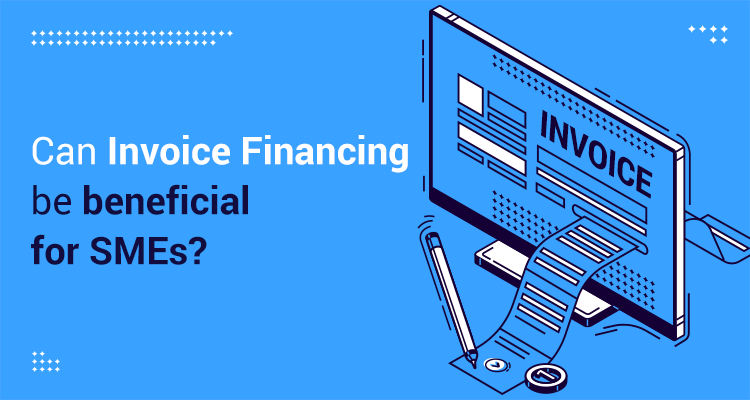Can Invoice Financing Be Beneficial for SMEs?

Continuous supply of money helps a business to survive the challenges in an ever-changing market. Unfortunately, there is no set rule book to guide through the storm. Comprehending the size and the scope of the problem and making necessary adjustments to survive the hard times may result in good business sometimes.
During economic hardships, most business owners immediately turn to bank loans for funds. But bank loans may not be the best financing option for small and medium-sized businesses (SMEs), especially with strict loan qualification requirements of banks and restrictions due to government regulations.
As an alternative financing, it is good to tap the power of invoice financing. In this form of funding a business owner uses the existing invoices as collateral to borrow money against the amount due from customers.
Invoice financing is essentially a financial product where an enterprise uses its accounts receivables to borrow money from bank or an NBFC. In some cases, a business can also sell its invoices to a third party at a discount, in exchange for immediate cash and a range of services. In such cases, the customers will pay the third party directly for the invoices sold.
How Invoice Financing Works
When SMEs sell goods or services to customers (wholesalers or retailers), the customer does not pay immediately for the goods that it purchases. The seller then issues an invoice and gives the buyer a window of a few days (30 to 120 days) to complete the payment on set terms. By offering the services to customers or buyers on credit, the seller blocks the funds that a business might otherwise use to run its operations.
To have a positive influx of cash, the seller can then approach different lenders or fintech companies who buy the invoice through a sale agreement or lend money against it. In exchange, the seller gets a cash advance equivalent to a certain percentage of the invoices. The rest is charged by the lender as its fees. When the buyer pays on the agreed date and time, the balance of the invoice is remitted back to the seller after excluding a service fee.
It is a win-win situation for both the parties as it allows SMEs to improve their cash flow and capitalize on future opportunities while also allowing customers to buy more stock.
Sapna aapka. Business Loan Humara.
Apply NowPros and Cons Of Invoice Financing For SMEs
Invoice financing is a faster way of accessing funds. Once the customer verifies the invoice, the seller can get a cash advance in a few business days. In invoice financing, credit score isn’t a problem. Hence, it is ideal for startups or SMEs that are in their transition phase of growth.
Unlike a conventional bank loan, a borrower is allowed to lend a stipulated amount of money. The loan amount is to be returned over a specified amount of time with an interest which is slightly on the higher side. Also, in this form of financing SMEs do not need to give added collateral as the invoice itself works as the collateral.
Invoice financing can be useful for businesses that have high sales costs. It is also ideal for businesses that seek confidential financing, allowing businesses to strengthen relationships with important customers.
This brings us to two forms of invoice financing—invoice discounting or invoice factoring. In the former, enterprises retain control over the sales ledger. The seller himself collects the invoice amount from customers on maturity unlike in invoice factoring, where the financier collects the unpaid invoices from customers. Invoice discounting is popular with businesses who want to maintain privacy.
However, the liability rests on the SMEs, in case the customers do not pay. Sometimes, it affects the seller-buyer relationship, in case the third party fails to keep a good relation with the either side. The main problem associated with invoice financing is that it has high factoring fees. Financial services firms usually deduct processing charges and interest, which reduces the actual value of the total invoice amount.
Present-day invoice funding lenders offer up to 90% of the value of the bills with repayment plans ranging from 15 days to six months, depending on factors like business size, and repayment cycle.
Conclusion
Invoice financing helps to shorten the working capital cycle. Rather than being overburdened by promises, it helps companies that have cash flow problems to borrow cash against unpaid invoices. It is an easier alternative to traditional bank loans. Also, it spares the enterprises of the responsibility of collecting payments.
However, lenders do not approve invoice financing applications of all SMEs. They approve financing requests only after looking at the current sales volume of a business.
IIFL Finance, through its Digital Finance program, collaborates with e-commerce portals, fintech companies to offer innovative financial solutions to its clients. IIFL Finance also offers both secured and unsecured business loans at competitive interest rates and customized repayment terms to help SMEs grow their business ventures.
Sapna aapka. Business Loan Humara.
Apply NowDisclaimer: The information contained in this post is for general information purposes only. IIFL Finance Limited (including its associates and affiliates) ("the Company") assumes no liability or responsibility for any errors or omissions in the contents of this post and under no circumstances shall the Company be liable for any damage, loss, injury or disappointment etc. suffered by any reader. All information in this post is provided "as is", with no guarantee of completeness, accuracy, timeliness or of the results etc. obtained from the use of this information, and without warranty of any kind, express or implied, including, but not limited to warranties of performance, merchantability and fitness for a particular purpose. Given the changing nature of laws, rules and regulations, there may be delays, omissions or inaccuracies in the information contained in this post. The information on this post is provided with the understanding that the Company is not herein engaged in rendering legal, accounting, tax, or other professional advice and services. As such, it should not be used as a substitute for consultation with professional accounting, tax, legal or other competent advisers. This post may contain views and opinions which are those of the authors and do not necessarily reflect the official policy or position of any other agency or organization. This post may also contain links to external websites that are not provided or maintained by or in any way affiliated with the Company and the Company does not guarantee the accuracy, relevance, timeliness, or completeness of any information on these external websites. Any/ all (Gold/ Personal/ Business) loan product specifications and information that maybe stated in this post are subject to change from time to time, readers are advised to reach out to the Company for current specifications of the said (Gold/ Personal/ Business) loan.



